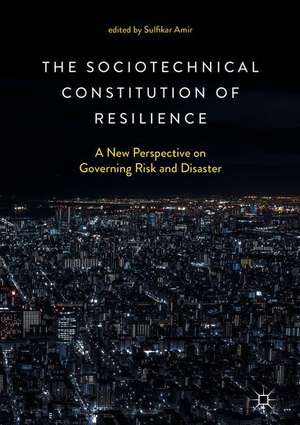The Sociotechnical Constitution of Resilience: A New Perspective on Governing Risk and Disaster
Editat de Sulfikar Amiren Limba Engleză Hardback – 31 mai 2018
| Toate formatele și edițiile | Preț | Express |
|---|---|---|
| Paperback (1) | 779.39 lei 6-8 săpt. | |
| Springer Nature Singapore – 3 ian 2019 | 779.39 lei 6-8 săpt. | |
| Hardback (1) | 784.61 lei 6-8 săpt. | |
| Springer Nature Singapore – 31 mai 2018 | 784.61 lei 6-8 săpt. |
Preț: 784.61 lei
Preț vechi: 956.84 lei
-18% Nou
Puncte Express: 1177
Preț estimativ în valută:
150.18€ • 163.19$ • 126.23£
150.18€ • 163.19$ • 126.23£
Carte tipărită la comandă
Livrare economică 21 aprilie-05 mai
Preluare comenzi: 021 569.72.76
Specificații
ISBN-13: 9789811085086
ISBN-10: 9811085080
Pagini: 332
Ilustrații: XV, 289 p. 21 illus.
Dimensiuni: 148 x 210 x 26 mm
Greutate: 0.52 kg
Ediția:1st ed. 2018
Editura: Springer Nature Singapore
Colecția Palgrave Macmillan
Locul publicării:Singapore, Singapore
ISBN-10: 9811085080
Pagini: 332
Ilustrații: XV, 289 p. 21 illus.
Dimensiuni: 148 x 210 x 26 mm
Greutate: 0.52 kg
Ediția:1st ed. 2018
Editura: Springer Nature Singapore
Colecția Palgrave Macmillan
Locul publicării:Singapore, Singapore
Cuprins
Introduction: Resilience as Sociotechnical Construct.- PART 1 DISSECTING RESILIENCE.- What (Sociotechnical) Resilience is Made of: Personal Trajectories and Erathquake Risk Mitigation in the San Francisco Bay Area.- Sociotechnical Resilience—From Recovery to Adaptation and Beyond: the Journey So Far….- Mapping Sociotechnical Resilience.- PART 2 DISRUPTED ENVIRONMENTS.- Weather Ready Nation or Ready Weather Agency?: Emphatic Accuracy and Sociotechnical Resilience in the National Weather Service.- Coping with Indonesia’s Mudflow Disaster.- PART 3 INFORMATIONAL RELATIONS.- Information Infrastructure and Resilience in American Disaster Plans.- An Audience Perspective on Disaster Response.- PART 4 ENGINEERED SYSTEMS.- Post-Fukushima Controversy on SPEEDI System: Contested Imaginary of Real-Time Simulation Technology for Emergency Radiation Protection.- Saving Onagawa: Sociotechnical Resilience in the 3.11 Disaster.- PART 5 URBAN LIFE.- An SME Driven Approach to Adopting Measures of Flood Resilience: A UK-Based Perspective.- How Resilience Discourses Shape Cities: the Case of Resilient Rotterdam.
Notă biografică
Sulfikar Amir is an Associate Professor of science, technology, and society in the School of Social Sciences, Nanyang Technological University, Singapore. His research interests include science and technology studies, development, globalisation, disaster, risk, resilience, and infrastructure and city studies. He is the author of 'The Technological State in Indonesia: the Co-constitution of High Technology and Authoritarian Politics'. His ongoing project explores the production of hidden vulnerability in the Fukushima nuclear meltdown.
Textul de pe ultima copertă
This book considers the concept of resilience in a global society where coping with the consequence and long term impact of crisis and disaster challenges the capacity of communities to bounce back in the event of severe disruption. Catastrophic events such as the 9.11 terrorist attack, the Fukushima nuclear disaster, and the volcano eruption in Central Java entailed massive devastation on physical infrastructures, and caused significant social and economic damage. This book considers how the modern sociotechnological system facilitating human activity defines how societies survive and whether a crisis will be short-lived or prolonged. Drawing on the concept of sociotechnical resilience, this book closely examines a range of events North America, Asia, Australia, and Europe. By presenting the successes and failures of sociotechnical resilience, it offers important insights and practical lessons to build better and comprehensive understandings of resilience in a real-worldsetting, significantly contributing to the study of disaster resilience.
Caracteristici
Sheds light on how resilience is embodied in the hybrid nature of complex sociotechnical systems Explores the sociotechnical constitution of resilience by closely examining different stories and events in the North America, Asia, Australia, Europe, and the Pacific Islands Offers important insights and practical lessons to build better and comprehensive understandings of resilience
